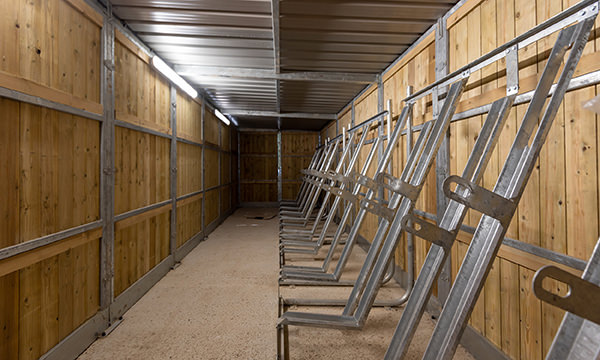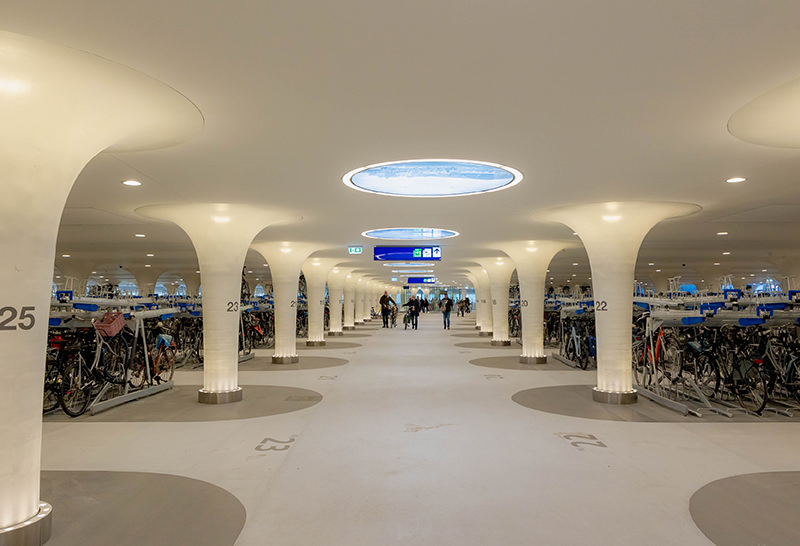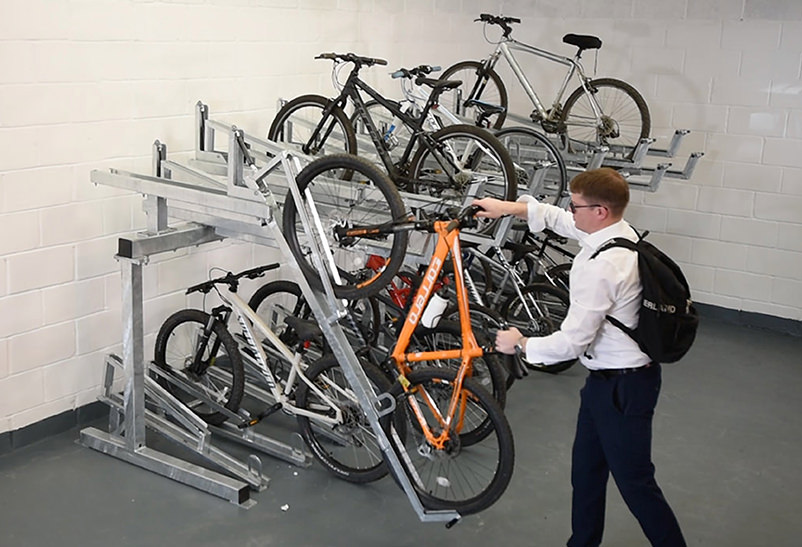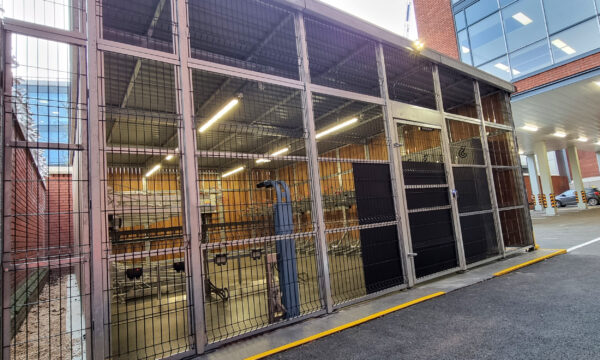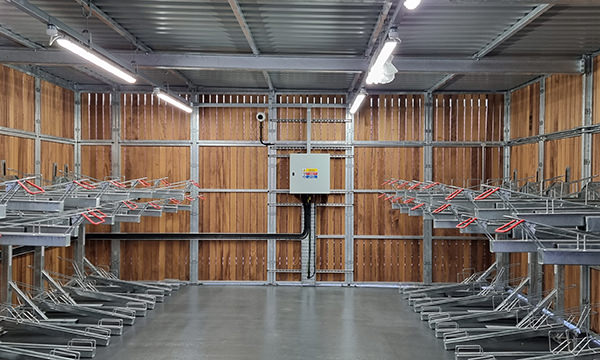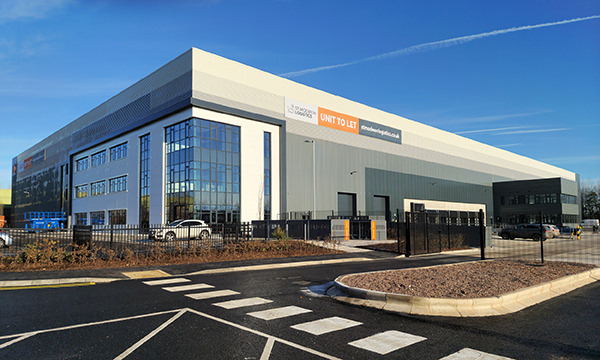Table of Contents:
Secure bike parking is seeing increased integration at public transport hubs on busy urban corridors, encouraging cycling uptake for commuters. In turn this is helping to reduce reliance on car travel, as well as the demand for car parking spaces at these high-traffic and often high-density settings.
To make cycling more accessible for commuters in getting to and from the transport hub, bike parking solutions need to be convenient, easy to use, provide enough capacity so that users are always assured of a parking space, and offer security levels that provide reassurance for users.
Essential Requirements for Setting
Bike parking & storage solutions for public transport hubs need to:
- Provide a designated parking and storage area that ensures bikes are parked in an orderly manner and unable to cause obstruction to through traffic.
- Be installed in a prominent position to ensure line of sight and be within convenient distances of public transport access points.
- Be of a durable, high-quality build and able to withstand daily wear and tear. Maintenance schedules can be a key component for ensuring this.
- Meet and potentially exceed the relative capacity requirements to accommodate potential variations in demand and ensure space for all users.
- Provide effective shelter against inclement weather to encourage use and ensure optimum protection for stored bikes.
- Provide appropriate lighting fixtures to assist with access during non-daylight hours, whilst aiding bike theft prevention by providing visibility.
It can be highly beneficial for larger facilities to provide access to practical features like bike pumps and repair tools to offer users on-the-go maintenance, as well as additional amenities such as showers, changing rooms, and personal lockers. It’s also worth considering that public bike parking facilities are required to be capable of passing Secured by Design Level 2 testing, or at least Level 1 if the facility is installed in a secured environment.
Public Bike Parking Standards
Installing secure bike parking in urban settings such as public transport hubs will raise its own specific requirements. The Bicycle Association and Cycle Rail Working Group have published their Standards for Public Cycle Parking guide that outlines the requirements for public bike parking in the UK. In addition, a summary of these requirements can be found in the following article on UK Bike Parking Standards.
As a concept, public transport hubs are already widely established in a number of European cities, and are increasingly spreading in the UK. The city of Cambridge recently developed a new bike park at the city’s railway station, constructed as part of their station redevelopment in 2016, accommodating nearly 3,000 bikes in an effort to provide secure bike parking for commuters and city residents.
Earlier this year, a substantial underwater bike parking garage opened at Amsterdam’s Centraal Station, the result of a 4-year, €60m investment. The structure holds space for 11,000 bikes in total, and, remarkably, is only the second largest bike parking facility in the Netherlands. Utrecht’s Stationsplein is considered the largest bike parking facility in the world, with space for 12,500 bikes.
Bike Parking Solutions
Bike stands and racks, when installed as a standalone installation, can be appropriate for settings that require small to medium capacity storage for short-term use. For public transport hubs, combining these with an open or enclosed unit to improve security and provide effective shelter is crucial for accommodating longer term use.
Secure, long-term bike storage solutions for public transport hubs include:
- Bike Stores: Highly versatile and offering efficient footprint in high-density settings, bike stores offer a configurable design platform that can accommodate vertical, semi-vertical, and level housing of bikes within a secure, weather-protected unit. This is typically achieved within a single-row layout, alongside options for locking systems and access control with Secured by Design specifications.
- Bike Hubs: Bike Hubs are designed to accommodate the optimum number of bikes within the available footprint, with opportunities to combine various bike parking types in a single or double row layout, all in one dedicated, secure facility. Bike Hubs are ideal for settings with high foot-traffic like public transport hubs and provide a flexible design platform to ensure no compromise is made towards space efficiency or security.
- Bike Modules and Lockers: Appealing to owners of high-value bikes, bike modules and lockers offer individually secure bike parking that combines durability with ease of use. Comprising an enclosed design to shield the bike from view and deter bike theft, bikes are stored in an upright position and locked to ensure they remain stable. Ideal for on-the-go users, bike lockers and modules utilise space efficiency to accommodate high-density settings, while sequential positioning can be utilised to form a connected series of units.
Bike Parking Solutions with urbanspec
As sustainability strategies and urban planning develops, the requirement for innovative, high-quality bike parking products at public transport hubs is increasing. Offering an extensive product line that spans bike stands, racks, shelters, lockers, stores and hub buildings, bike parking and storage solutions from urbanspec utilise an integrated design and engineering methodology that combines volume manufacture with custom build capability.
The prevention of bike theft is central to urbanspec product design, with bike hubs, bike stores and bike modules able to meet Secure By Design specifications, accredited by Sold Secure. Access control options for bike stores and hubs, such as mechanical keypad and smartphone access systems, are accommodated within a high-quality steel door and frame design, enabling users to have confidence that their bikes will be safely stored in use.
A substantial resource and knowledge base enables urbanspec to simplify specifications, utilising CAD models, NBS specifications and datasheets available for download. Supporting CPD programmes provide clarity on the optimal approach to aspects such as security considerations and effective space planning.
